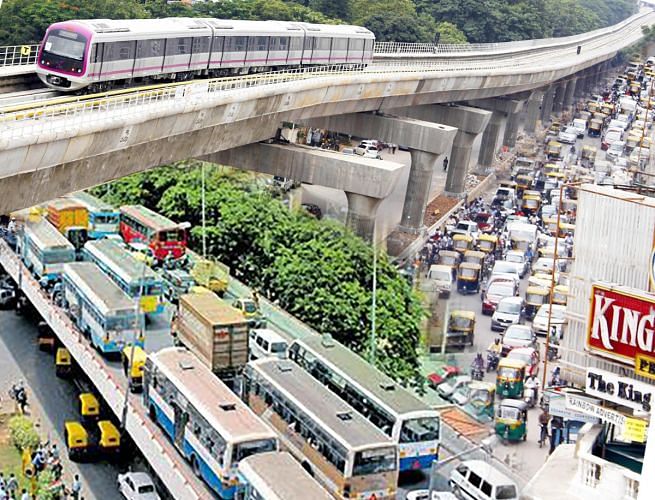
A slow and steady dissent is fast brewing among Bengalureans against the state government’s proposed elevated corridor project across the city.
Almost two years since the entire Bengaluru rallied against the controversial steel flyover project, citizens from all walks of life are joining yet another time to raise their voice against the upcoming elevated corridor project. Planned to decongest the choked streets of Bengaluru, the project has repeatedly run into controversy owing to unscientific planning and enormous costs.
The mega project — a network of six interconnected elevated corridors spanning the length and breadth of Bengaluru — is not something new or thought out overnight by the government.
In fact, it is the logic and timing behind the project that stoked controversy as and when the project was mooted by governments. While the citizens have been calling for a sustainable approach to resolve the burgeoning traffic menace and reduce vehicular pollution which is taking a toll on city’s air quality, the government has been proposing cost enduring structures like steel flyover or elevated corridors which would eventually pave way for even more vehicles and increased traffic.
Unlike the steel flyover project where the government was stubborn until the last minute, the elevated corridor project seems to have made the government soft and receptive to the feelings of general public. Evident to the fact, Chief Minister H D Kumaraswamy has already remarked that if the people do not want the project, the government will shelve it.
Launch timing
Besides, activists have also raised objections to the timing of the launch, as it coincides with major elections. While the previous government floated the project when the Assembly polls were round the corner, the present Congress-JD(S) coalition government has mooted the project when the Lok Sabha polls are on the cards.
Sources in the state government revealed that the genesis of the project goes back to 2015 when urban activist R K Mishra proposed the project which was later taken over by the Bruhat Bengaluru Mahanagara Palike (BBMP). However, since its inception, the project has evoked bitter criticism from people and experts who have threatened to go on intense protests on the lines of the steel flyover agitation. Convincing the citizens about the project, the government has been toeing the paradoxical line which is further widening the gap between the government and the angry public.
Pollution vs traffic
Alarmed by Karnataka State Pollution Control Board (KSPCB) findings that 42% of pollution is caused by vehicles, the state government on the one hand joins the league of C40 cities Air Quality network, and on the other, proposes an elevated corridor which experts are terming as an invitation to more traffic.
Dr Ashish Verma of the civil engineering department of the IISc argues that the project is nothing but an irony. The same government which is taking measures to curb air pollution is talking about constructing more flyovers.
“By constructing flyovers, we are encouraging people to use personal vehicles. The city of London is planning to have about 80% of modal share through public transport comprising walking, cycling etc. But nobody knows why our city is thinking the other way round,” he wondered.
Urban expert V Ravichander said this kind of functioning in government is similar to how two hands of the same body function together, without knowing one another. “It is important to have a comprehensive plan that considers all the aspects. The elevated corridor project is more like a project-oriented thinking rather than outcome-oriented,” he said.
Like any other project, the elevated corridor has also left the city divided. However, it has not many in its support. Urban activists like R K Mishra and Nitin Sheshadri have been by and large united in their stand about the project.
“Several academic studies have confirmed that elevated motorway reduces pollutant concentrations at ground level. In fact, pollution as a result of an elevated flyover is mitigated by two factors: source of pollution is at a higher level than the pedestrians, and idling vehicle engines during jams is arguably the worst form of pollution,” said Sheshadri.
Initially conceived as a mega network of five elevated corridors linking various directions of the city, the project spanning 75 km was mooted in 2015. Subsequently, in the same year, the state government asked the Bruhat Bengaluru Mahangara Palike to conduct a detailed project report (DPR). However, till date, according to activists, the government has not made the findings public.
Later on, the project was handed over to the Karnataka Road Development Corporation Limited (KRDCL) under the Public Works Department (PWD), which again prepared a report in 2017 and extended the length of the corridor from 75 km to 92 km. But with stiff opposition and the government completing its tenure, the project was put on back burner.
With the Congress-JD(S) coalition government assuming power, the project was rekindled and given wing. Chief Minister H D Kumaraswamy gave it an official sanctity by announcing it in his state budget and made an allocation of Rs 1,000 crore.